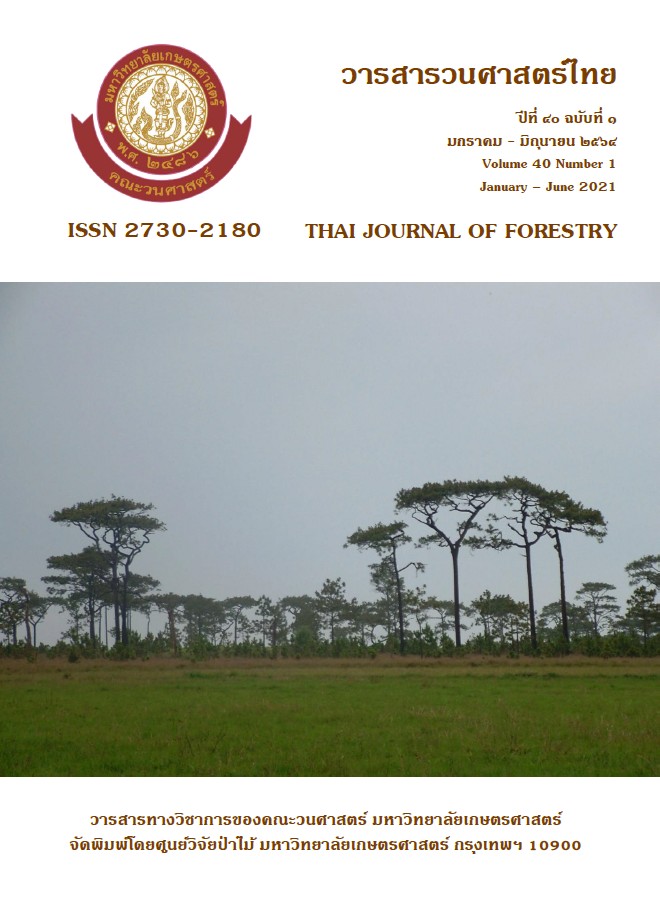การประยุกต์ระบบสารสนเทศภูมิศาสตร์ ในการวิเคราะห์การเปลี่ยนแปลง การใช้ประโยชน์ที่ดิน บริเวณลุ่มน้ำสาขาแม่ถาง จังหวัดแพร่
Main Article Content
บทคัดย่อ
การวิจัยครั้งนี้มีวัตถุประสงค์เพื่อประยุกต์ระบบสารสนเทศภูมิศาสตร์ ในการวิเคราะห์การเปลี่ยนแปลงการใช้ประโยชน์ที่ดิน บริเวณลุ่มน้ำสาขาแม่ถาง จังหวัดแพร่ ในช่วง ปี 2550-2562 และพื้นที่เสี่ยงต่อการเปลี่ยนแปลงการใช้ประโยชน์ที่ดิน รวมทั้งเสนอแนวทางในการจัดการทรัพยากรธรรมชาติและสิ่งแวดล้อมบริเวณพื้นที่ลุ่มน้ำต่อไป
ผลการวิจัยพบว่า ลุ่มน้ำสาขาแม่ถาง จังหวัดแพร่ มีพื้นที่ประมาณ 120 ตารางกิโลเมตร จำแนกการใช้ประโยชน์ที่ดิน ออกเป็น 5 ประเภท ได้แก่ พื้นที่ป่าไม้ พื้นที่เกษตรกรรม พื้นที่เมืองและสิ่งปลูกสร้าง พื้นที่แหล่งน้ำ และพื้นที่เบ็ดเตล็ด เมื่อวิเคราะห์ในช่วง ปี 2550–2556 พบว่า มีการเปลี่ยนแปลงการใช้ประโยชน์ที่ดิน คือ 41.33 ตารางกิโลเมตร โดยพื้นที่ป่าไม้ลดลงมากที่สุด ร้อยละ 24.29 พื้นที่ที่มีการเพิ่มขึ้นมากที่สุด คือ พื้นที่เกษตรกรรม โดยเพิ่มขึ้นร้อยละ 68.76 ของการเปลี่ยนแปลงการใช้ประโยชน์ที่ดิน ปี 2550 ส่วนการเปลี่ยนแปลงการใช้ประโยชน์ที่ดินช่วงปี 2556–2562 พบว่า มีการเปลี่ยนแปลงการใช้ประโยชน์ที่ดิน คือ 9.69 ตารางกิโลเมตร โดยพื้นที่เกษตรกรรมลดลงมากที่สุด ร้อยละ 8.88 พื้นที่ที่มีการเพิ่มขึ้นมากที่สุด คือ พื้นที่ป่าไม้เพิ่มขึ้น ร้อยละ 7.19 ของการเปลี่ยนแปลงการใช้ประโยชน์ที่ดิน ปี 2556 เมื่อทำการวิเคราะห์พื้นที่ป่าไม้ที่เสี่ยงต่อการเปลี่ยนแปลงการใช้ประโยชน์ที่ดิน พบว่า มีพื้นที่เสี่ยงต่อการเปลี่ยนแปลงการใช้ประโยชน์ที่ดินต่ำ ปานกลาง และสูง คิดเป็นพื้นที่ 66.60, 16.02 และ 37.80 ตารางกิโลเมตร หรือร้อยละ 55.31, 13.30 และ 31.39 ของพื้นที่ลุ่มน้ำสาขาแม่ถาง ตามลำดับ สำหรับแนวทางที่สามารถเพิ่มพื้นที่ป่าไม้ได้อย่างต่อเนื่องนั้น ได้พิจารณาจากยุทธศาสตร์ นโยบาย และสถานการณ์ต่าง ๆ เข้ามาเสนอแนวทางการจัดการบริเวณพื้นที่ลุ่มน้ำต่อไป
คำสำคัญ: ระบบสารสนเทศภูมิศาสตร์ การใช้ประโยชน์ที่ดิน ลุ่มน้ำสาขาแม่ถาง จังหวัดแพร่
Downloads
Article Details

This work is licensed under a Creative Commons Attribution-NonCommercial-NoDerivatives 4.0 International License.
ข้าพเจ้าและผู้เขียนร่วม (ถ้ามี) ขอรับรองว่า ต้นฉบับที่เสนอมานี้ยังไม่เคยได้รับการตีพิมพ์และไม่ได้อยู่ในระหว่างกระบวนการพิจารณาตีพิมพ์ลงในวารสารหรือสิ่งตีพิมพ์อื่นใด ข้าพเจ้าและผู้เขียนร่วม (ถ้ามี) ยอมรับหลักเกณฑ์และเงื่อนไขการพิจารณาต้นฉบับ ทั้งยินยอมให้กองบรรณาธิการมีสิทธิ์พิจารณาและตรวจแก้ต้นฉบับได้ตามที่เห็นสมควร พร้อมนี้ขอมอบลิขสิทธิ์ผลงานที่ได้รับการตีพิมพ์ให้แก่วารสารวนศาสตร์ คณะวนศาสตร์ มหาวิทยาลัยเกษตรศาสตร์ กรณีมีการฟ้องร้องเรื่องการละเมิดลิขสิทธิ์เกี่ยวกับภาพ กราฟ ข้อความส่วนใดส่วนหนึ่ง หรือ ข้อคิดเห็นที่ปรากฏในผลงาน ให้เป็นความรับผิดชอบของข้าพเจ้าและผู้เขียนร่วม (ถ้ามี) แต่เพียงฝ่ายเดียว และหากข้าพเจ้าและผู้เขียนร่วม (ถ้ามี) ประสงค์ถอนบทความในระหว่างกระบวนการพิจารณาของทางวารสาร ข้าพเจ้าและผู้เขียนร่วม (ถ้ามี) ยินดีรับผิดชอบค่าใช้จ่ายทั้งหมดที่เกิดขึ้นในกระบวนการพิจารณาบทความนั้น”
References
Congalton, R.G. and K. Green. 1998. Assessing the Accuracy of Remotely Sensed Data: Principles and Practices. Lewis, New York.
Geo-Informatics and Space Technology Development Agency (Public Organization) (GISTDA). 2009. Space Technology and Geo-Informatics. Ministry of Higher Education, Science, Research and Innovation, Bangkok. (in Thai)
Land Development Department. 2019. Land Use Change, Phrae Province During 2007 - 2019. Ministry of Agriculture and Cooperatives, Bangkok. (Aerial photograph). (in Thai)
Office of the National Economics and Social Development Board. 2018. The 12th National Economic and Social Development Plan. Office of the Prime Minister, Bangkok. (in Thai)
Office of the Phrae Province. 2016. Phrae Province Development Plan 2018-2021. Available Source: http://phrae.go.th/file_data/province61-64.pdf, January 20, 2020.
Royal Forest Department. 2019. Forest Strategy 2017 – 2036. Ministry of Natural Resources and Environment, Bangkok. (in Thai)
Secretary of the National Strategy Committee. 2018. National Strategy 2018 - 2037. Office of the National Economics and Social Development Board, Bangkok. (in Thai)
Watcharakitti, S. 1982. Land Use Classification System. Department of Forestry Management, Faculty of Forestry, Kasetsart University, Bangkok. (in Thai)
Wildlife Conservation Office. 2003. Comprehensive report, Application of Data from Remote sensing and Geographic Information System to Investigate Changes in Forest Land Use Changes in Huai Sala Wildlife Sanctuary, Si Saket Province. Wildlife Conservation Office, Department of National Parks, Wildlife and Plant Conservation, Bangkok. (in Thai)

